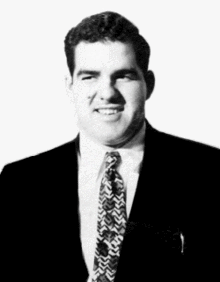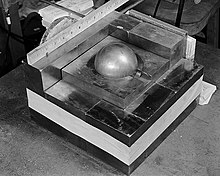Harry Daghlian
Haroutune Krikor Daghlian Jr. , called Harry Daghlian , ( Armenian Հարություն Գրիգոր Դաղլյան կրտսեր Harutjun Krikor Daghljan krtner ; born May 4, 1921 in Waterbury (Connecticut) , † September 15, 1945 in Los Alamos (New Mexico) ) was an American Physicist of Armenian descent. He is considered to be the first victim of a nuclear accident .
Life
Harry Daghlian was the first of three children of Haroutune Krikor Daghlian and his wife Margaret Rose, nee Currie. Shortly after his birth, the family moved to New London, Connecticut , where his father got a job as an X-ray assistant at Lawrence & Memorial Hospital . He attended Harbor Elementary School in New London and played the violin in the school orchestra. Daghlian developed a penchant for math and science at a very early age and was named the best student in the school. His inclinations were encouraged by his father and uncle Garabed K. Daghlian, who was a professor of physics and astronomy at Connecticut College , New London. In 1938 Daghlian received his high school diploma from Bulkeley High School . He then began undergraduate studies at the Massachusetts Institute of Technology . After two years, Daghlian moved to Purdue University in West Lafayette (Indiana) , where he received his Bachelor of Science in spring 1942 . He then began a graduate fellowship study . For the Manhattan project - the development of an atomic bomb - suitable employees were sought nationwide. Robert Oppenheimer used his contacts at several universities in the United States to recruit staff for his project. One of his contacts was Marshall Holloway from Purdue University, who gave a lecture in Los Alamos in the spring of 1943. On that occasion, Holloway and three members of his working group were hired by Oppenheimer. They started in Los Alamos in autumn 1943. Daghlian probably came to Los Alamos in spring 1944 after completing his studies. In the area of TA-2, the Omega -Gelände (Omega site) , he was first in the Water Boiler Group and later in Critical Assembly Group . The group was led by Otto Frisch . Among other things, Daghlian worked on assembling the core for the Trinity test , which took place on July 16, 1945.
The nuclear accident
One of the tasks of the Critical Assembly Group was to determine the influence of various neutron reflectors on the critical mass of plutonium . In Los Alamos, the attempts were called tickling the dragon's tail (" tickling the dragon's tail "). This name comes from Richard Feynman .
On August 21, 1945, a few weeks after the two atomic bombs were dropped on Hiroshima and Nagasaki , Daghlian left the regular Tuesday lecture at 9:00 p.m. Originally, experiments with a plutonium test core were planned for the next day, which Daghlian wanted to carry out that evening - for reasons unknown to this day. At about 9:30 p.m. Daghlian reached the Omega site. In the test laboratory was the soldier Robert J. Hemmerly, who was doing his duty in Los Alamos as a “scientist in uniform” as part of the special engineering detachment program .
The test core - it was nicknamed “Rufus” - consisted of two hemispheres δ-plutonium with a total mass of 6.2 kg, which were coated with a nickel layer about 100 µm (= 4 mils ) thick . The density of the plutonium was 15.7 g / cm³. Daghlian stacked blocks of tungsten carbide around the sphere of plutonium , which reflected the neutrons emitted by the plutonium . Each cuboid had a mass of about 4.4 kg.
When Daghlian moved the last cuboid over the structure with his left hand at 9:55 p.m. - the total reflector mass with this cuboid would have been 236 kg - he determined with the help of the neutron counter that this cuboid would have made the structure supercritical. When he withdrew his hand, the cube slipped from him and fell into the center of the structure. As a result, the reflection of the neutrons was suddenly increased, and the system became “ promptly supercritical ”. A performance excursion ensued, and Daghlian instinctively removed the cuboid with his right hand, which was enveloped in a bluish glow. Then he began to dismantle the blocks.
A student then drove Daghlian to Los Alamos Hospital, where he arrived within half an hour, while Hemmerly alerted a sergeant . At first Daghlian felt a numbness in the hand, which was replaced by a tingling sensation. As a result of radiation sickness , his condition continued to worsen. In the hospital, Daghlian was visited daily by his friend Louis Slotin . Slotin had a doctorate in physics and also worked in Frisch's group. Daghlian fell into a coma a few days before his death. He died on September 15, 1945 at 4:30 p.m. at the age of 24 as a result of radiation sickness.
The New York Times published a report from the Associated Press on September 21, 1945 , according to which six days earlier a "worker died from burns sustained in an industrial accident ." The real reasons for the accident and the course of the accident did not become known until 1956, as they were initially classified as a war secret.
In this accident about 10 16 nuclear fission occurred, which led to an estimated radiation dose of 5.1 Sievert for Daghlian . Robert J. Hemmerly received a radiation dose of about 0.5 Sievert. The nickel coating of the plutonium core survived the accident without cracks. On October 2, 1945, Daghlian's accident was reconstructed at Los Alamos National Laboratory to determine the radiation dose released. In this experiment 6 · 10 15 fission were measured. The promptly supercritical state was not reached.
On May 21, 1946, Louis Slotin carried out an experiment with the same plutonium hemispheres. As a result of an accident, Slotin was also badly irradiated and died on May 30, 1946, also of radiation sickness. The experimental core was then given the name Demon Core .
literature
- Radiation Death - Tickled the Dragon . In: Der Spiegel . No. 31 , 1965, p. 79-80 ( online ).
Web links
- A backward glamor. (PDF; 3.1 MB) Weapons Science and Engineering at Los Alamos National Laboratory, March / April 2003, with a colored photo by Harry Daghlian
Individual evidence
- ^ JH Tashjian: The Armenian American in World War II. Verlag Harenik Associates, 1952, p. 150.
- ^ A safety review of the Oak Ridge Critical Experiments Facility . ( Memento of February 22, 2018 in the Internet Archive ; PDF; 99 kB) ORNL / TM-349, Oak Ridge National Laboratory, 1962, SRDB Ref ID: 15646
- ^ Accidents in the Manhattan Project. From: Atomic Heritage Foundation. Retrieved May 16, 2011
- ↑ a b c d A. Dion: Los Alamos and the Omega Site Accident. Retrieved May 16, 2011
- ↑ a b c d D. Overbye: Theatrical Elegy Recalls A Victim of Nuclear Age. In: New York Times, April 3, 2001
- ↑ E. welsome: The plutonium files: America's secret medical experiments in the Cold War. Dial Press, 1999, p. 109, ISBN 0-385-31402-7
- ^ Special Engineer Detachment. Atomic Heritage Foundation, accessed February 21, 2018 .
- ↑ Special Engineering Detachment (SEDs) ( Memento from February 1, 2012 in the Internet Archive ) At: Los Alamos National Laboratory. Retrieved May 17, 2011
- ↑ KN Roark: Criticality accidents report issued ( Memento of July 16, 2012 in the Internet Archive ) of July 19, 2000, accessed on May 17, 2011
- ↑ a b c d A Review of Criticality Accidents - 2000 Revision (PDF; 3.9 MB) Los Alamos National Laboratory, LA-13638, May 2000, p. 68. According to: DF Hayes: A Summary of Accidents and Incidents Involving Radiation in Atomic Energy Activities. June 1945 through December 1955. US Atomic Energy Commission, TID-5360, 1956. and HC Paxton: Booby Traps. Los Alamos Scientific Laboratory, Los Alamos, NM, AECD-4240, 1957.
- ↑ Atomic bomb worker died 'from burns' In: New York Times of September 21, 1945
| personal data | |
|---|---|
| SURNAME | Daghlian, Harry |
| ALTERNATIVE NAMES | Daghlian, Haroutune Krikor Daghlian Jr. (full name) |
| BRIEF DESCRIPTION | American physicist |
| DATE OF BIRTH | May 4, 1921 |
| PLACE OF BIRTH | Waterbury (Connecticut) |
| DATE OF DEATH | September 15, 1945 |
| Place of death | Los Alamos (New Mexico) |

